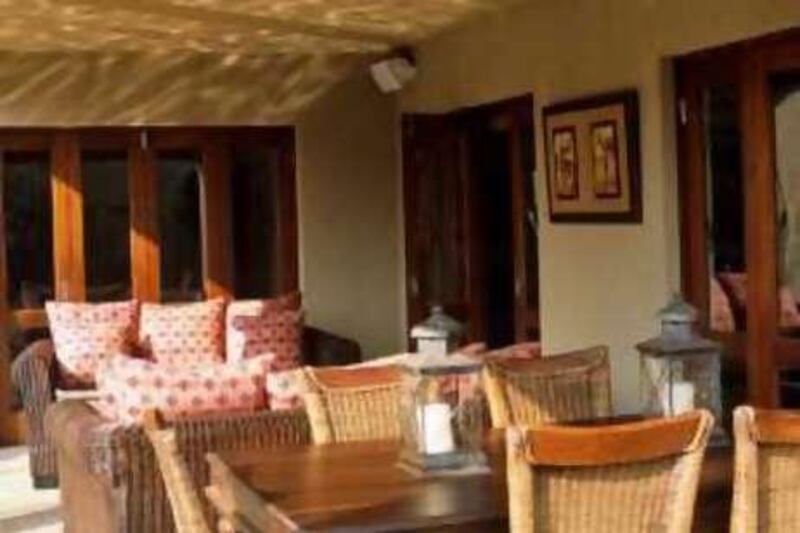When it comes to outdoor dining, ambience is the most important ingredient, says Carmen Clews, the managing partner of Harlequin Marquees in Dubai. "It's all in creating the atmosphere for a perfect dinner party - not how much you've spent on the furniture. And there are plenty of ways in which you can make even the most basic set-up look good."
Current trends are all about bringing the interior of your home into the garden. For furniture, play with fabrics and colour. Use similar materials to those within your house. If you have a basic table, cover it with a cloth and make seat cushions to match those indoors. Take your interior scheme outside by painting an exterior wall in the same hue. This works particularly well if the outside dining space is situated close to French windows, so that the spaces seem to overlap.
"I love using mirrors outside," says Hatty Pedder, an artist and professional stylist living in Dubai. "If you hang them on an exterior wall they make a nice focal point and give an area the illusion of space." Mirrors of all sizes can create visual impact - from tiny mosaic sized tiles that pick out patterns on walls, paths and tableware, to wall-sized panels placed behind trellis and trailed with climbing plants to trick the eye. Even disco glitter balls can be points of interest. And not just at night; hang one to catch the sun and add dancing specks of light to your alfresco lunchtime.
Positioning your dining space is important too, Duncan Denley, an associate at Cracknell Landscape Architects in Dubai, advises: "Do you require shade for day time dining or shelter from prevailing winds, for example? Exposed dining areas are rarely successful." Ideally, your dining area should be located close to where the food will be prepared to avoid long treks. Don't locate it immediately adjacent to a barbecue, though, as the smoke can be a nuisance.
Think about the surroundings and views. "Try to ensure there is something to look at - a sculpture, an attractive view of the rest of the garden or a water feature," says Denley. If space is limited, as is typical of so many UAE houses that have tiny walled gardens, why not experiment with those external walls to differentiate your dining area? Polystyrene pieces textured to look like stonework or plaster can be painted and fixed to a wall as a point of interest. And it needn't look like a naff themed restaurant; these days there are some good, realistic-looking examples around. You could even add a Romanesque Mouth of Truth mask as a focal point.
However, Pedder cautions: "Decide on your theme and stick to it. Don't mix futuristic furniture and neat, slick lines with traditional Arabic barasti fencing and coloured Moroccan lamps. It just won't gel." For a touch of Tuscany, invest in interesting, terracotta planters and climatically hardy foliage. These can be used to section off your dining space from the rest of the garden. Exterior walls can be painted in warm spice tones and a traditional stone water feature makes a good focal point. Dress plants with fairy lights for evening dining. "Plain white are best as they add a magical touch, while candles in storm lanterns are romantic," says Clews.
Think about shade too. If you have no trees or shrubs and your taste leans towards the contemporary, seek out the latest canopies. Available in a range of plain colours and geometric shapes, they provide relief from the midday sun and a cosy cover that can be under-lit by night. Play with panelling to enclose your space. Wooden lattice, trellis or clipped hedges work well with contemporary styles and warm colours provide a sense of intimacy. Select shades that complement your choice of canopy and consider uplighters to illuminate the space. "An attractive pot with an oil burner hidden in the bottom, among some pebbles, can make an atmospheric mood," says Denley, adding that uplighting trees and fountains can further add to the ambience.
To create warmth, light and an interesting feature, firepits come in many guises - from antique-style copper or wrought iron basins to Oriental pagoda-style pits - and can be filled with anything from wood and charcoal to recycled glass chips and lava chunks. Contemporary dining spaces are complemented by clean lines, so marble or fixed stone firepits look best. Be sure to use weatherproof materials. For paving, granite is aesthetically pleasing, durable, stain-resistant and requires little maintenance. "Timber, although attractive and cool underfoot, requires a good deal of maintenance. And food falling between decking planks can encourage pests," warns Denley.
Choose furniture that will endure the high summer temperatures. "The latest outdoor materials are UV-stable," says Clews. "They look like modern versions of wicker and come in cool contemporary designs." And finally, she says, consider the night-time wildlife: "Don't forget to invest in Citronella candles to keep the mosquitoes away".





